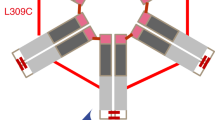Abstract
A considerable progress has been achieved in the comprehension of the cellular and molecular mechanisms that account for the therapeutic benefit of intravenous immunoglobulin (IVIg) in several autoimmune and inflammatory conditions. However, the precise mechanisms responsible for such a wide range of biological activities have not been proven unambiguously. A wide range of specificities have been identified within IVIg including idiotypes of immunoglobulins, T cell receptor, HLA molecules, several cell surface molecules of immunological importance such as CD4, CD5, Fas, BAFF, cytokines and cytokine receptors, chemokine receptors, CD40 among others. Here we identify and characterize the natural autoantibodies of IgG isotype directed against the human Fc receptors. We show that the F(ab′)2 of IVIg recognize the FcγRIII (CD16) and FcγRII (CD32). Interestingly, the immunopurified anti-FcγIII and anti-FcγII antibodies isolated from IVIg bind soluble and membrane-bound FcR and inhibit rosette formation. Altogether, these results along with previous reports provide pointers on the existence of functionally relevant natural autoantibodies towards a wide range of self-motifs that may participate in regulation of the immune response. Their presence in the therapeutic immunoglobulin preparations may explain at least in part, the beneficial effect of IVIg in autoimmune diseases.


Similar content being viewed by others
References
Coutinho A, Kazatchkine MD, Avrameas S. Natural autoantibodies. Curr Opin Immunol. 1995;7:812–8.
Durandy A, Kaveri SV, Kuijpers TW, Basta M, Miescher S, Ravetch JV, et al. Intravenous immunoglobulins: understanding properties and mechanisms. Clin Exp Immunol. 2009;158:2–13.
Madi A, Bransburg-Zabary S, Kenett DY, Ben-Jacob E, Cohan IR. The natural autoantibody repertoire in newborns and adults. Adv Exp Med Biol. 2012;750:198–212.
Avrameas S, Selmi C. Natural autoantibodies in the physiology and pathophysiology of the immune system. J Autoimmun. 2013;41:46–9.
Saint-Remy JM. Autoantibodies to coagulation factors. Haemophilia. 2010;16:56–60.
Nimmerjahn F, Ravetch JV. FcγRs in health and disease. Curr Top Microbiol Immunol. 2011;350:105–25.
Ravetch JV, Bolland S. IgG FC receptors. Annu Rev Immunol. 2001;19:275–90.
Nimmerjahn F, Ravetch JV. Fcγ receptors as regulators of immune responses. Nat Rev Immunol. 2008;8:34–47.
Loone RJ, Huggins J. Use of intravenous immunoglobulin G (IVIG). Best Pract Res Clin Haematol. 2006;19:3–25.
Vani J, Elluru S, Negi VS, Lacroix-Desmazes S, Kazatchkine MD, Bayry J, et al. Role of natural antibodies in immune homeostasis: IVIg perspective. Autoimmun Rev. 2008;7:440–4.
Bonagura VR. Using intravenous immunoglobulin (IVIG) to treat patients with primary immune deficiency disease. J Clin Immunol. 2013;33:S90–4.
Damianovich M, Blank M, Raiter A, Hardy B, Shoenfeld Y. Anti-vascular endothelial growth factor (VEGF) specific activity of intravenous immunoglobulin (IVIg). Int Immunol. 2009;21:1057–63.
Dunn-Siegrist I, Leger O, Daubeuf B, Poitevin Y, Dépis F, Herren S, et al. Pivotal involvement of Fcγ receptor IIA in the neutralization of lipopolysaccharide signaling via a potent novel anti-TLR4 monoclonal antibody 15C1. J Biol Chem. 2007;282:34817–27.
Astier A, de la Salle H, de la Salle C, Bieber T, Esposito-Farese ME, Freund M, et al. Human epidermal Langerhans cells secrete a soluble receptor for IgG (Fc gamma RII/CD32) that inhibits the binding of immune complexes to Fc gamma R+ cells. J Immunol. 1994;152:201–12.
D’Arrigo C, Candal-Couto JJ, Greer M, Veale DJ, Woof JM. Human neutrophil Fc receptor-mediated adhesion under flow: a hollow fibre model of intravascular arrest. Clin Exp Immunol. 1995;100:173–9.
Vivier E, da Silva AJ, Ackerly M, Levine H, Rudd CE, Anderson P. Association of a 70-kDa tyrosine phosphoprotein with the CD16: zeta: gamma complex expressed in human natural killer cells. Eur J Immunol. 1993;23:1872–6.
Koenderman L, Hermans SW, Capel PJ, van de Winkel JG. Granulocyte-macrophage colony-stimulating factor induces sequential activation and deactivation of binding via a low-affinity IgG Fc receptor, hFc gamma RII, on human eosinophils. Blood. 1993;81:2413–9.
Bayry J, Negi VS, Kaveri SV. Intravenous immunoglobulin therapy in rheumatic diseases. Nat Rev Rheumatol. 2011;7:349–59.
Wong A, Kenny TP, Ermel R, Robbins DL. IgG3 reactive rheumatoid factor in rheumatoid arthritis: etiologic and pathogenic considerations. Autoimmunity. 1994;19:199–210.
Boros P, Chen JM, Bona C, Unkeless JC. Autoimmune mice make anti-Fc gamma receptor antibodies. J Exp Med. 1990;171:1581–95.
Boros P, Odin JA, Chen J, Unkeless JC. Specificity and class distribution of Fc gamma R-specific autoantibodies in patients with autoimmune disease. J Immunol. 1994;152:302–6.
Sajedi V, Movahedi M, Aghamohammadi A, Gharagozlou M, Shafiei A, Soheili H, et al. Comparison between sensitivity of autologous skin serum test and autologous plasma skin test in patients with Chronic Idiopathic Urticaria for detection of antibody against IgE or IgE receptor (FcεRIα). Iran J Allergy Asthma Immunol. 2011;10:111–7.
Mannoor K, Xu Y, Chen C. Natural autoantibodies and associated B cells in immunity and autoimmunity. Autoimmunity. 2013;46:138–47.
Samuelsson A, Towers TL, Ravetch JV. Anti-inflammatory activity of IVIG mediated through the inhibitory Fc receptor. Science. 2001;291:484–6.
Bierlinga P. Intravenous immunoglobulin for autoimmune thrombocytopenic purpura. Hum Immunol. 2005;4:387–94.
Rouard H, Tamasdan S, Moncuit J, Moutel S, Michon J, Fridman WH, et al. Fc receptors as targets for immunotherapy. Int Rev Immunol. 1997;16:147–85.
Sautès C, Galinha A, Bouchard C, Mazières N, Spagnoli R, Fridman WH. Recombinant soluble Fc gamma receptors: production, purification and biological activities. J Chromatogr B Biomed Appl. 1994;662:197–207.
Teillaud JL, Bouchard C, Astier A, Teillaud C, Tartour E, Michon J, et al. Natural and recombinant soluble low-affinity Fc gamma R: detection, purification, and functional activities. Immunomethods. 1994;4:48–64.
Galon J, Gauchat JF, Mazières N, Spagnoli R, Storkus W, Lötze M, et al. Soluble Fcgamma receptor type III (FcgammaRIII, CD16) triggers cell activation through interaction with complement receptors. J Immunol. 1996;157:1184–92.
de la Salle H, Galon J, Bausinger H, Spehner D, Bohbot A, Cohen J, et al. Soluble CD16/Fc gamma RIII induces maturation of dendritic cells and production of several cytokines including IL-12. Adv Exp Med Biol. 1997;417:345–52.
Author information
Authors and Affiliations
Corresponding author
Rights and permissions
About this article
Cite this article
Bouhlal, H., Martinvalet, D., Teillaud, JL. et al. Natural Autoantibodies to Fcγ Receptors in Intravenous Immunoglobulins. J Clin Immunol 34 (Suppl 1), 4–11 (2014). https://doi.org/10.1007/s10875-014-0019-2
Received:
Accepted:
Published:
Issue Date:
DOI: https://doi.org/10.1007/s10875-014-0019-2




